Signal Hill, St. John's
| Signal Hill | |
|---|---|
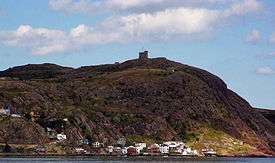 | |
| Location | St. John's, Newfoundland and Labrador, Canada |
| Coordinates | 47°34′11″N 52°40′55″W / 47.56972°N 52.68194°WCoordinates: 47°34′11″N 52°40′55″W / 47.56972°N 52.68194°W |
| Governing body | Parks Canada |
| Website | Signal Hill National Historic Site |
_p0703_ST_JOHN'S.jpg)
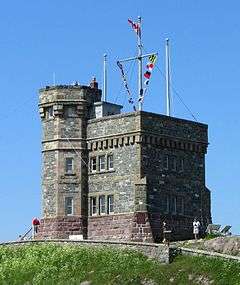
Signal Hill is a hill which overlooks the city of St. John's, Newfoundland and Labrador, Canada.
Due to its strategic placement overlooking the harbour, fortifications have been built on the hill since the mid 17th century.
History
The final battle of the Seven Years' War in North America was fought in 1762 at the Battle of Signal Hill, in which the French surrendered St. John's to a British force under the command of Lt. Colonel William Amherst. Lt. Colonel Amherst renamed what was then known as "The Lookout" as "Signal Hill," because of the signalling that took place upon its summit from its flagmast. Flag communication between land and sea would take place there from the 17th century until 1960.
During Signal Hill's first construction period in the late 18th century, Signal Hill was designated as the citadel for St. John's.
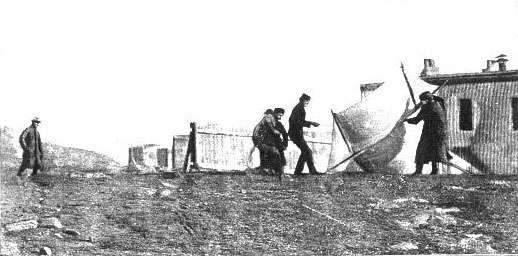
During the 19th century, Signal Hill was manned specifically during the Napoleonic Wars and the American Civil War. A second construction period in Signal Hill's history saw the construction of the Queen's Battery Barracks, which has been completely restored to the period of 1862.
Construction on Cabot Tower began in 1897 to commemorate Queen Victoria's Diamond Jubilee in 1897 and the 400th anniversary of John Cabot's landfall in 1497. The building was declared officially open in 1900. The practical uses of the building were flag mast signalling, and a Marconi wireless station which has since been moved to St. John's International Airport.
On 12 December 1901, the first transatlantic wireless transmission was received here by Guglielmo Marconi in an abandoned fever and diphtheria hospital, which has since been destroyed by fire.[1] The transmission, in Morse code, originated from his Poldhu Wireless Station, Cornwall, UK.
The United States maintained anti-aircraft guns on the hill during World War II.
Signal Hill National Historic Site
Signal Hill is a National Historic Site of Canada.[2][3]
Signal Hill Tattoo
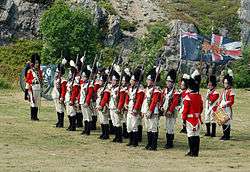
The Signal Hill Tattoo showcases the Royal Newfoundland Regiment of Foot from 1812, the Royal Newfoundland Regiment Band from 1795, and the Royal Newfoundland Regiment of 1917. Wearing full military uniforms as per the period, the soldiers give a display by each section and portray the drills and battle tactics of the time. The Artillery provide an exhibition of cannon fire to add to the program.
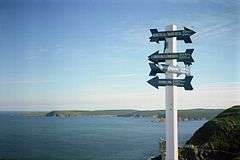
Activities
Cabot Tower, located at the top of the hill, features exhibits about Guglielmo Marconi and the wireless station that operated in the tower. There is a gift shop, and an amateur radio station VO1AA, which may be operated by visiting amateur radio operators in the summer months. It is sponsored by the Society Of Newfoundland Radio Amateurs. An active amateur radio repeater, VO1AAA 146.790+, is located inside the building and is operational year round.
The visitor centre features interactive exhibits and a film about the site's military and communications history, and the history of St. John's.
The North Head Trail is located along the Atlantic Ocean and the surrounding coast. The Lookout Trail features interpretive panels about the site's history.
Other features
Some distance down the hill is located the Johnson Geo Centre, a geology museum.
A tourist information radio station, CJSH-FM, broadcasts from the Signal Hill site.
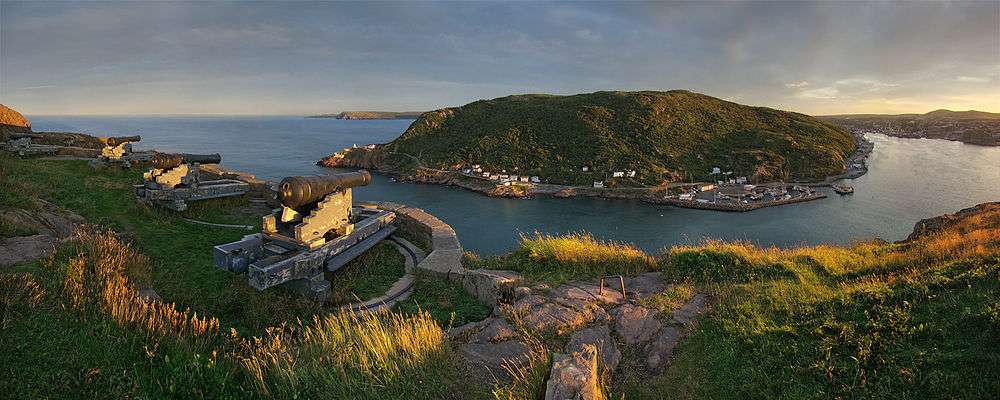
Climate
| Climate data for Signal Hill | |||||||||||||
|---|---|---|---|---|---|---|---|---|---|---|---|---|---|
| Month | Jan | Feb | Mar | Apr | May | Jun | Jul | Aug | Sep | Oct | Nov | Dec | Year |
| Record high °C (°F) | 16.0 (60.8) |
15.5 (59.9) |
15.0 (59) |
22.0 (71.6) |
25.0 (77) |
29.0 (84.2) |
29.5 (85.1) |
31.5 (88.7) |
28.5 (83.3) |
23.0 (73.4) |
19.0 (66.2) |
14.0 (57.2) |
31.5 (88.7) |
| Average high °C (°F) | −0.5 (31.1) |
−0.9 (30.4) |
1.5 (34.7) |
5.3 (41.5) |
10.6 (51.1) |
15.4 (59.7) |
19.8 (67.6) |
20.2 (68.4) |
16.1 (61) |
10.6 (51.1) |
6.0 (42.8) |
1.5 (34.7) |
8.8 (47.8) |
| Daily mean °C (°F) | −4.2 (24.4) |
−4.7 (23.5) |
−2.0 (28.4) |
2.0 (35.6) |
6.4 (43.5) |
10.9 (51.6) |
15.3 (59.5) |
16.2 (61.2) |
12.5 (54.5) |
7.5 (45.5) |
3.1 (37.6) |
−1.5 (29.3) |
5.1 (41.2) |
| Average low °C (°F) | −7.9 (17.8) |
−8.4 (16.9) |
−5.4 (22.3) |
−1.3 (29.7) |
2.1 (35.8) |
6.3 (43.3) |
10.9 (51.6) |
12.2 (54) |
8.9 (48) |
4.4 (39.9) |
0.1 (32.2) |
−4.5 (23.9) |
1.45 (34.62) |
| Record low °C (°F) | −20.0 (−4) |
−23.0 (−9.4) |
−23.0 (−9.4) |
−11.5 (11.3) |
−10.0 (14) |
−2.0 (28.4) |
3.0 (37.4) |
4.0 (39.2) |
0.0 (32) |
−10.0 (14) |
−12.5 (9.5) |
−26.0 (−14.8) |
−26.0 (−14.8) |
| Average precipitation mm (inches) | 109.7 (4.319) |
106.8 (4.205) |
98.0 (3.858) |
104.1 (4.098) |
88.4 (3.48) |
83.3 (3.28) |
82.7 (3.256) |
84.4 (3.323) |
101.4 (3.992) |
133.0 (5.236) |
126.7 (4.988) |
123.2 (4.85) |
1,241.7 (48.886) |
| Average rainfall mm (inches) | 50.8 (2) |
51.9 (2.043) |
64.3 (2.531) |
85.3 (3.358) |
85.8 (3.378) |
83.3 (3.28) |
82.7 (3.256) |
84.4 (3.323) |
101.4 (3.992) |
133.0 (5.236) |
112.7 (4.437) |
72.2 (2.843) |
1,007.9 (39.681) |
| Average snowfall cm (inches) | 58.9 (23.19) |
54.9 (21.61) |
33.7 (13.27) |
18.9 (7.44) |
2.6 (1.02) |
0.0 (0) |
0.0 (0) |
0.0 (0) |
0.0 (0) |
0.0 (0) |
14.0 (5.51) |
50.9 (20.04) |
233.9 (92.09) |
| Source: Environment Canada[4] | |||||||||||||
References
- ↑ Atlantic Cable. IEEE Milestone Plaque
- ↑ Parks Canada.Signal Hill National Historic Site
- ↑ Signal Hill. Canadian Register of Historic Places. Retrieved 5 August 2012.
- ↑ "Signal Hill, St. John's". Canadian Climate Normals 1981–2010 (in English and French). Environment Canada. Retrieved September 1, 2015.
- Zierler, Amy, and Cam Mustard, Signal Hill: An Illustrated History, 1982, reprint 1997, Newfoundland Historic Parks Association, St. John's.
- Canadian Heritage - Parks Canada, Welcome to Signal Hill National Historic Site brochure, undated (2000 ?).
External links
| Wikimedia Commons has media related to Signal Hill, Newfoundland and Labrador. |
- Signal Hill National Historic Site - Parks Canada
- Atlas of Canada Relief Map